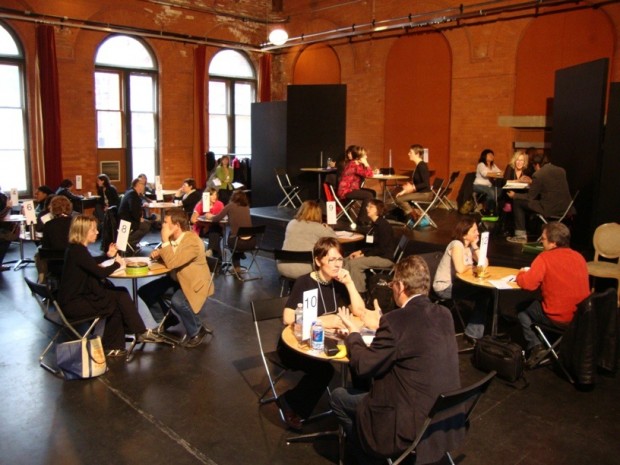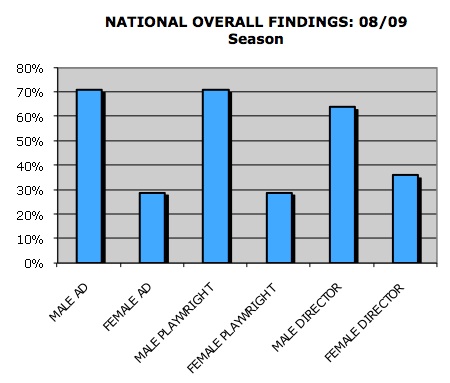Women making and attending theatre up. Women in charge of theatre still down.
by Lindsay Schwietz
When Rina Fratticelli’s report came out in 1982 revealing the amount of women in power positions in Canadian theatre to be shockingly low, the gender inequality issue was exposed. Yet, twenty-seven years later the PACT Equity in Canadian Theatre report on gender shows that very little has changed. In PACT theatres in the 2008-2009 season, women accounted for 29% of the artistic directors, 36% of the working directors and 29% of the produced playwrights. Primarily men are still running theatre companies across Canada. And the larger the theatre company, the less women in artistic leadership positions.
This is true despite the fact that there are more women in theatre schools and more women in audiences. According to the same report, almost 60% of the theatre-going audience in Canada is thought to be female and women account for 68% of student enrolment in the performing arts, communication and technologies fields. Yet, these percentages don’t match the employment opportunities for women.
Why is this happening? Why has very little changed in over twenty years? And what is being done about it? Are we going to be looking at these same statistics twenty years from now?
Kelly Thornton is Artistic Director of Nightwood Theatre, and co-head of the national advisory committee of Equity in Canadian Theatre: The Women’s Initiative, a group of activists whose aim is to formally investigate the status of women in Canadian theatre and develop plans to change existing barriers. She believes the lack of females is not something done on purpose, but created through subconscious choices by the male artistic directors that run 71% of the theatres in Canada.
“I don’t think they’re actually saying ‘we’ve got to keep women out’ – I just think there is a gender bias to the way we program seasons. I always use the analogy of a man and a woman walk into a bookstore. The two will both buy a novel and they will come out with totally different novels. And it’s based on their gender. Think of a male and a female AD – they’re gravitating towards stories that speak to them. And often that has to do with gender.”
Thornton stresses this is not an attack on men, or male AD’s. It’s about subconscious choices. “Who better to direct Bob’s play than Bill. It’s the domino effect.” Yet, when the primary ticket buyer is female, why is this not questioned more often? Why do women just accept watching male stories, directed by men, as the norm?
Many of these issues were discussed last month as 150 female directors from across Canada came to Toronto to take part in the week-long Directors Summit at the 4×4 Festival, sponsored by Nightwood Theatre. A mix of established and emerging directors participated in master classes, workshops, panel discussions, and seminars. With the statistics on the lack of gender balance being released this year, an event such as this is not only an opportunity for networking of female directors and theatre workers, but also a step towards solidarity in the face of these shocking numbers.

Nightwood Theatre's Directors Summit included a Marketplace for emerging directors to meet face-to-face and network with established professionals.
One of the main events of the summit was the Marketplace, where emerging female directors and artistic directors from across the country met in a speed-dating atmosphere. It allowed emerging directors to meet face-to-face and network with established professionals. This also ties in with The Canadian Women Directors Catalogue: a comprehensive list of Canadian Women Directors, an initiative by Nightwood Theatre currently in development, which will be sent out to theatres across Canada. The artistic directors who receive this catalogue will now have faces to put to names. Thornton hopes the experience will really get artistic directors “thinking about how to actually tangibly effect change by being conscious when they’re programming”.
Perhaps this is the key, as Thornton suggests, to effecting change: “This is a conscious-raising effort on my part. This is just about staying awake to the issues. When you’re making your season choices, always look at your roster… and try to include the other half of the planet. Have the grace to acknowledge the track record hasn’t been good in the past and pay more attention to it in the future….The culture will balance itself if we all just admit there is an issue and then tangibly take it on in our own way. Think globally, act locally. Do one thing per season that slightly changes the way you work,” says Thornton.
This is not only happening in Canada. In June of this year, Sphinx Theatre Company in Great Britain held the conference on gender Vamps, Vixens and Feminists: The Elephant in the Room. Among discussions of gender equality, were statistics from a 2006 Women in Theatre Survey, revealing that only 17% of playwrights produced in Britain were female, and only 23% of productions were directed by women.
In America, there has also been a lack of female directors and playwrights. In April of this year, Emily Glassberg Sands submitted to Princeton University a report entitled: Opening the Curtain on Playwright Gender: An Integrated Economic Analysis of Discrimination in American Theater. This report examined gender bias against female playwrights in the United States. Sands showed through experiments that, among other very interesting results, artistic directors believe that a script written by a female pen-name will make less money and be of lower quality than the same script with a male name as the playwright. Sands also mentions in her report that on Broadway in the 2008/09 season only 12.6% of the plays produced were written by women.
Would it actually affect the economic prospects of the play if it’s written or directed by a woman, telling female stories? In her opening remarks at the Kick Start Reception of the Directors Summit, Shaw Festival Artistic Director Jackie Maxwell spoke of her experience: “I did this, I got a whole bunch of female directors in and I dug up all the female playwrights from that time period, and I just want to let you know that the sky didn’t fall, that the audiences didn’t go away, that nobody actually knew the difference. The success was still the same.”
If we are all conscious of what choices we make as theatre practitioners, and if we are all aware of these inequalities, the small changes will become big changes. As Mary Vingoe, inaugural Artistic Director of the Magnetic North Festival, said while facilitating a panel on Women Directing in Canadian Theatre, “hopefully in ten years we won’t have to be having this same discussion.”



Thanks very much for this Michael. It is so incredibly frustrating to continually see casting breakdowns looking for five men and one woman. Over and over again. I realize more than ever how important it is for women to make our own work!
When I was in theatre school, we were one of the few classes with far more women than men, and the administration had a hard time knowing what to do with us. We were constantly double-cast, or playing men – but paying the same tuition, mind you. And it’s not incredibly useful to list all of the wonderful male parts you’ve played on your CV when you’re leaving school!
Happy holidays!
Hey Shira,
Thanks for your thanks – though I should point out that Lindsay wrote the piece. Once again my major role was to push for bar graphs… My favourite theatre school trick is when instead of doing enough plays for everyone to learn, they just do one, and everyone gets to play the same part at different moments in the show. “We are all Hamlet”, just none of us learn about what kind of stamina it would take to play him.
Anyhow, check out this new show Necessary Angel is working on that it seems Luminato has gotten behind:
http://www.necessaryangel.com/toutcommeelle
Drop in the bucket, but you know.
Happy Holidays to you too!
The minute after I pressed send on the last comment I stumbled on to this: The deadline is soon!
Tout Comme Elle (English-Language Premiere). Director Brigitte Haentjens. Casting Contact: Morgan Norwich / morgan@necessaryangel.com. Deadline For Submissions December 30, 2009. Audition Dates & Locations January 13-14, 2010 (Location To Be Confirmed). Call Back Dates & Locations January 15, 2010 (Location TBC). Rehearsals Start Early/Mid May 2011 (TBC). Official Opening Early June 2011 (TBC). Closing Mid June 2011 (TBC). Role(s) Available: 50 female actors of all types, ages (18+), shapes, sizes, cultural backgrounds, abilities, levels of experience and interests needed. Singing ability an asset but not required. Submission Instructions Please send a hard copy headshot and resume to: Necessary Angel, c/o Morgan Norwich, 513 Manning Avenue, Toronto, ON, M6G 2V8. Deadline: December 30, 2009. Please note: What age range you play; whether you would characterize yourself as a ‘singer’; if you are available May 10-23, 2010 for a possible workshop (TBC); and whether you are a French-speaker. Storyline: Necessary Angel, together with acclaimed Quebec director and Siminovitch Prize-winner Brigitte Haentjens, will collaborate with a diverse group of fifty women on the development of a large-scale new work entitled Tout Comme Elle. Tout Comme Elle is a poignant and daring piece of theatre about the inevitability of loss and the eternal nature of love. The play combines song, movement and music with a rich and poetic text to explore the difficult, painful, yet necessary separation of daughter and mother. The English-language Premiere of Tout Comme Elle will take place in June 2011, Tout Comme Elle has been commissioned by the Luminato Toronto Festival of Arts + Creativity. For more information, visit http://www.necessaryangel.com/toutcommeelle. We will only be accepting hard copy submissions. Open to Equity and non-union.
Including ‘the other half of the planet’ as Kelly Thornton says in this fantastic article is the key forward for so many aspects of society. If we continue to put effort into educating women and girls all over the world (as is so wonderfully outlined in the book ‘Half the Sky: Turning Oppression into Opportunity for Women Worldwide by Nicholas Kristof and Sheryl Wudunn), the result will be that more women and girls will be in decision making positions, including in the arts, and the idea of ‘gender bias’ can slowly but surely become a thing of the past. Thank you for posting this article. Happy New Year!
[…] https://praxistheatre.com/2009/12/women-making-and-attending-theatre-up-women-in-charge-of-theatre-st… […]
[…] Women making and attending theatre up.Women in charge of theatre still down. […]
[…] https://praxistheatre.com/2009/12/women-making-and-attending-theatre-up-women-in-charge-of-theatre-st… […]